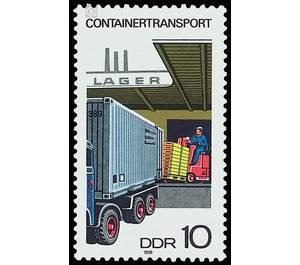container Shipping - Germany / German Democratic Republic 1978 - 10 Pfennig
Theme: Post & Philately
| Country | Germany / German Democratic Republic |
| Issue Date | 1978 |
| Face Value | 10.00 |
| Color | multi-colored |
| Perforation | K 12 1/2: 13 |
| Printing Type | offset |
| Stamp Type | Postage stamp |
| Item Type | Stamp |
| Chronological Issue Number | 2068 |
| Chronological Chapter | GER-DDR |
| SID | 862979 |
| In 21 Wishlists | |
Container transport On the subject of container transport, the Ministry of Posts and Telecommunications of the German Democratic Republic issued four multicolored special postage stamps: Special cancellation from 28 June to 27 August 1978 10 years of large container transport in the GDR With the introduction of large container transport in the GDR became made a valuable contribution to improving the quality of freight transport. With its help, in addition to the pallets, small and medium-sized container systems, the economy will be offered a further technology with the consistent application of which it will be possible to build up further rational transport chains from consignor to consignee. This also meets the objective requirement for further rationalization of transport, handling and storage. After all the conditions had been met, the first large containers were transported on June 29, 1968 on the route from Dresden via Berlin to Rostock Überseehafen. Meanwhile, the number of large containers transported annually increased to 348,000 by 1977. With 21 special large-container trans-shipment terminals of the German Reichsbahn and another six factory-owned public container trans-shipment terminals, which are available to other users in the catchment area, about 60 to 70 percent of the territory of the GDR can be reached in large container transport. Through the inclusion of the overseas port of Rostock, the connection to the international shipping lines is also established. Preferably, large containers are effectively used in the transport of high quality lumpy goods. Therefore, the German Reichsbahn holds for the uniform container park of the GDR mostly closed universal large container. This park has now grown to about 15,000 large containers. The basic technology envisages the transport of the railroad in special large container trains between the large container transshipment points, while the transport to and from the large container handling center takes place through the VE public motor transport. The number of large containers used for the export and import of high-quality foreign trade goods in cross-border sea and land transport is also rapidly growing. Transports to and from the other CMEA countries are developing particularly rapidly, with traffic to the USSR once again taking the lead. 10 Pfennig value: Large container load in one operation Large containers bring the highest effectiveness where they are directly involved in production, in-house transport and storage. With the help of mechanized loading and handling activities, it is possible to reduce the still high proportion of heavy physical labor in the areas of the national economy and to increase labor productivity. Particular advantages are achieved if the companies purchase their own large containers, which are then used in a rational exchange process in inter-company transport.


